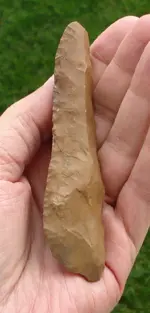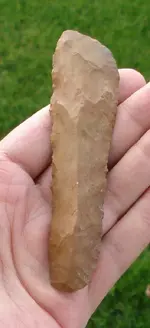uniface
Silver Member
- Joined
- Jun 4, 2009
- Messages
- 3,216
- Reaction score
- 2,905
- Golden Thread
- 0
- Location
- Central Pennsylvania
- Primary Interest:
- Other
According to Kentucky Archaeology by Dr. R. Barry Lewis (p. 31) :
By comparison with the preceding period [Clovis], the Middle Paleoindian [Gainey, Barnes] tool kit exhibits a number of differences. For example, prismatic blades and polyhedral cores are absent. The core and blade technology was replaced by the technique called bipolar lithic reduction. (Notes in brackets are mine).
Since Paleo technology was more or less continental in breadth (certainly, regionally uniform), this is an example of a large Clovis Prismatic (triangular in cross section) Blade. It was found at Coffee Slough, Alabama, is 4 11/16" in length, and made of river-stained Fort Payne chert.
It's a recent score from our own Jerry Sherman (Paleoworld), who I recommend highly as an honest and knowledgeable source of stuff you have no hope of finding yourself.
By comparison with the preceding period [Clovis], the Middle Paleoindian [Gainey, Barnes] tool kit exhibits a number of differences. For example, prismatic blades and polyhedral cores are absent. The core and blade technology was replaced by the technique called bipolar lithic reduction. (Notes in brackets are mine).
Since Paleo technology was more or less continental in breadth (certainly, regionally uniform), this is an example of a large Clovis Prismatic (triangular in cross section) Blade. It was found at Coffee Slough, Alabama, is 4 11/16" in length, and made of river-stained Fort Payne chert.
It's a recent score from our own Jerry Sherman (Paleoworld), who I recommend highly as an honest and knowledgeable source of stuff you have no hope of finding yourself.
Attachments
Upvote
0



